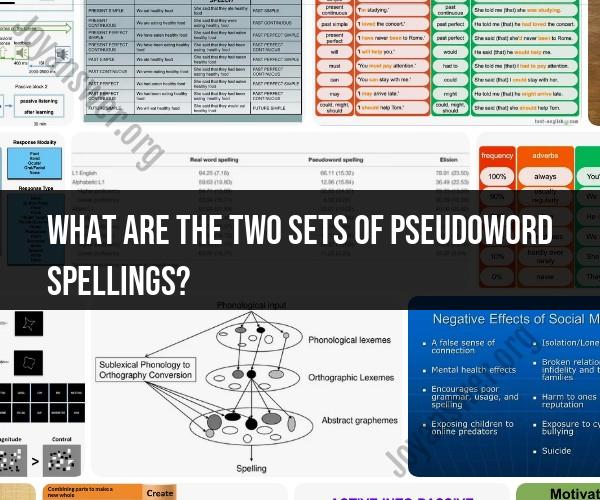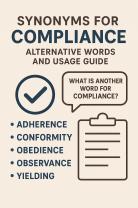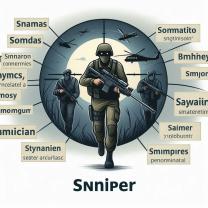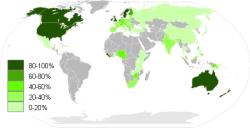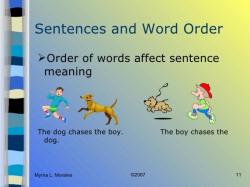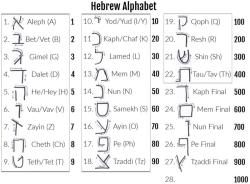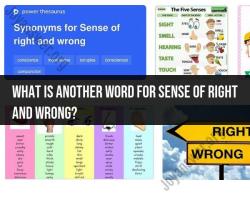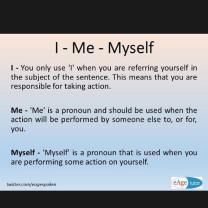What are the two sets of pseudoword spellings?
In the context of linguistics and psycholinguistics, pseudoword spellings are essentially non-words or made-up words that follow the spelling conventions of a particular language. These pseudoword spellings are often used in research to understand how people apply spelling rules and patterns.
There isn't a fixed "two sets of pseudoword spellings." Instead, researchers create pseudowords based on the phonological and orthographic rules of a language. Pseudowords are typically divided into two categories:
Regular Pseudowords:
- Regular pseudowords are constructed according to the consistent spelling rules and patterns of a language. For example, in English, a regular pseudoword might follow the pattern of consonant-vowel-consonant (CVC) or vowel-consonant-vowel (VCV) with letter combinations that are plausible based on English spelling rules. An example of a regular pseudoword is "blonk."
Irregular Pseudowords:
- Irregular pseudowords are constructed in a way that violates common spelling rules or includes unconventional letter combinations. These pseudowords are designed to test how well individuals can adapt to unusual or irregular spellings. An example of an irregular pseudoword is "knope," which doesn't follow the usual "kn" pattern in English.
Researchers use both regular and irregular pseudowords to investigate spelling abilities, phonological processing, and the cognitive processes involved in reading and writing. These pseudowords allow them to study how individuals apply their knowledge of spelling rules and patterns, even when presented with unfamiliar or nonsensical words.
Exploring Pseudoword Spellings: Two Sets for Linguistic Analysis
Pseudowords are non-existent words that are created by combining letters and syllables in a way that is consistent with the spelling rules of a language. Pseudoword spelling tasks are used to assess spelling skills and to study the cognitive processes involved in spelling.
Here are two sets of pseudowords for linguistic analysis:
Set 1:
- flenk
- smog
- drent
- zark
- plip
Set 2:
- plempt
- grackle
- splinter
- squish
- glisten
These pseudowords were created using a variety of spelling patterns, including:
- CVC: flenk, smog, drent, plip
- CVCC: zark
- CCVCC: plempt
- CVCV: grackle
- CVCVCV: splinter
- VCCV: squish
- VCCVVC: glisten
These pseudowords can be used to assess a variety of spelling skills, such as the ability to:
- Decode spelling patterns
- Apply spelling rules
- Spell words with complex spelling patterns
Investigating Pseudoword Spelling Patterns: Research and Applications
Research on pseudoword spelling has shown that pseudoword spelling performance is a strong predictor of real word spelling performance. This suggests that pseudoword spelling tasks can be used to identify students who are at risk for spelling difficulties and to assess the effectiveness of spelling instruction.
Pseudoword spelling tasks have also been used to study the cognitive processes involved in spelling. For example, researchers have used pseudoword spelling tasks to investigate the role of phonological awareness, orthographic knowledge, and morphological awareness in spelling.
Pseudoword spelling tasks have a number of applications in the field of linguistics. They can be used to:
- Assess spelling skills
- Identify students who are at risk for spelling difficulties
- Evaluate the effectiveness of spelling instruction
- Study the cognitive processes involved in spelling
The Role of Pseudoword Spelling in Linguistic Studies
Pseudoword spelling plays an important role in linguistic studies. It is used to investigate a variety of topics related to spelling, such as the relationship between phonological awareness and spelling, the role of orthographic knowledge in spelling, and the impact of morphological awareness on spelling.
Pseudoword spelling tasks can also be used to study the development of spelling skills in children and to compare the spelling skills of children from different language backgrounds.
Overall, pseudoword spelling is a valuable tool for linguistic research. It can be used to assess spelling skills, to identify students who are at risk for spelling difficulties, to evaluate the effectiveness of spelling instruction, and to study the cognitive processes involved in spelling.
In addition to the applications listed above, pseudoword spelling can also be used to:
- Develop new spelling assessment tools
- Investigate the relationship between spelling and other cognitive skills, such as reading and writing
- Study the impact of different language factors on spelling, such as dialect and socioeconomic status
Pseudoword spelling is a powerful tool for linguistic research that can be used to gain a deeper understanding of the complex process of spelling.
